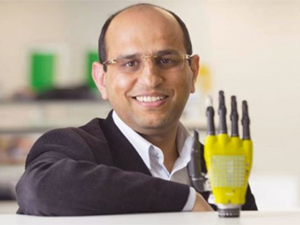



Date:27/03/17
 Engineers at the University of Glasgow in Scotland have developed an innovative way of using the sun to power a "synthetic skin" used on prosthetic limbs.
Engineers at the University of Glasgow in Scotland have developed an innovative way of using the sun to power a "synthetic skin" used on prosthetic limbs.
In a news release on Wednesday, the university said that the research could help to produce advanced prosthetic limbs "capable of returning the sense of touch to amputees."
The team at Glasgow had previously developed an "electronic skin" made from graphene to cover prosthetic hands, the university added. They had now developed a method which uses graphene's physical properties to harness the sun's energy and power the skin.
The university described graphene as a highly flexible form of graphite that is only a single atom thick but stronger than steel. In addition, it is both transparent and electrically conductive.
This "optical transparency" makes it capable of gathering energy from the sun in order to produce power.
Ravinder Dahiya, together with colleagues from his Bendable Electronics and Sensing Technologies group, had now added power generating photovoltaic cells to their electronic skin. Photovoltaic cells directly convert the light of the sun into electricity.
"Human skin is an incredibly complex system capable of detecting pressure, temperature and texture through an array of neural sensors which carry signals from the skin to the brain," Dahiya, from the university's School of Engineering, said.
"My colleagues and I have already made significant steps in creating prosthetic prototypes which integrate synthetic skin and are capable of making very sensitive pressure measurements," Dahiya added.
"Those measurements mean the prosthetic hand is capable of performing challenging tasks like properly gripping soft materials, which other prosthetics can struggle with."
Glasgow said that the new skin needs only 20 nanowatts of power per square centimeter, an amount "easily met even by the poorest-quality photovoltaic cells currently available on the market."
"The other next step for us is to further develop the power-generation technology which underpins this research and use it to power the motors which drive the prosthetic hand itself," Dahiya said. "This could allow the creation of an entirely energy-autonomous prosthetic limb."
The team's paper was published in the journal Advanced Functional Materials.
Engineers develop solar powered skin which could transform lives
 Engineers at the University of Glasgow in Scotland have developed an innovative way of using the sun to power a "synthetic skin" used on prosthetic limbs.
Engineers at the University of Glasgow in Scotland have developed an innovative way of using the sun to power a "synthetic skin" used on prosthetic limbs.In a news release on Wednesday, the university said that the research could help to produce advanced prosthetic limbs "capable of returning the sense of touch to amputees."
The team at Glasgow had previously developed an "electronic skin" made from graphene to cover prosthetic hands, the university added. They had now developed a method which uses graphene's physical properties to harness the sun's energy and power the skin.
The university described graphene as a highly flexible form of graphite that is only a single atom thick but stronger than steel. In addition, it is both transparent and electrically conductive.
This "optical transparency" makes it capable of gathering energy from the sun in order to produce power.
Ravinder Dahiya, together with colleagues from his Bendable Electronics and Sensing Technologies group, had now added power generating photovoltaic cells to their electronic skin. Photovoltaic cells directly convert the light of the sun into electricity.
"Human skin is an incredibly complex system capable of detecting pressure, temperature and texture through an array of neural sensors which carry signals from the skin to the brain," Dahiya, from the university's School of Engineering, said.
"My colleagues and I have already made significant steps in creating prosthetic prototypes which integrate synthetic skin and are capable of making very sensitive pressure measurements," Dahiya added.
"Those measurements mean the prosthetic hand is capable of performing challenging tasks like properly gripping soft materials, which other prosthetics can struggle with."
Glasgow said that the new skin needs only 20 nanowatts of power per square centimeter, an amount "easily met even by the poorest-quality photovoltaic cells currently available on the market."
"The other next step for us is to further develop the power-generation technology which underpins this research and use it to power the motors which drive the prosthetic hand itself," Dahiya said. "This could allow the creation of an entirely energy-autonomous prosthetic limb."
The team's paper was published in the journal Advanced Functional Materials.
Views: 482
©ictnews.az. All rights reserved.Similar news
- The mobile sector continues its lead
- Facebook counted 600 million active users
- Cell phone testing laboratory is planned to be built in Azerbaijan
- Tablets and riders outfitted quickly with 3G/4G modems
- The number of digital TV channels will double to 24 units
- Tax proposal in China gets massive online feedback
- Malaysia to implement biometric system at all entry points
- Korea to build Green Technology Centre
- Cisco Poised to Help China Keep an Eye on Its Citizens
- 3G speed in Azerbaijan is higher than in UK
- Government of Canada Announces Investment in Green Innovation for Canada
- Electric cars in Azerbaijan
- Dominican Republic Govt Issues Cashless Benefits
- Spain raises €1.65bn from spectrum auction
- Camden Council boosts mobile security





















